And when many evils and troubles have come upon them, this poem shall confront them as a witness, for it will live unforgotten in the mouths of their descendants. (Deuteronomy 31:21)
After five days on the Cape spent mostly exploring Eastham and Wellfleet we wanted to venture as far out (up) as we could and so to Provincetown.
The end of the road. The tip of the Outer Cape. The curled fist of the pugilistic geography of Cape Cod. The Cape stands firm as a kind of American response to anything that comes our way. Bring it on it seems to say. Sadly for me when I look at a map of this wonderful place my mind always shows me the mascot of the Notre Dame “Fighting Irish”.
So, we decide to make a trek in situ as we’d done every day of our time spent here: we’d walked Nauset Beach; Nauset Marsh to Coast Guard Beach; The Atwood-Higgins House and Bound Brook Island, including Ryder Beach; First Encounter Beach in Eastham; and our favorite going into this day, the Great Island in Wellfleet. This last had taken a full 4 hours and included a wooded area, a marsh, dunes and beach—we felt fully prepared for any other walk.
The guidebook offers two Lighthouse walks—one is all beach and one is through marsh an dunes to end up on the beach at the Lighthouse. We choose the latter, Race Point Lighthouse and set out. Henry David Thoreau had done this walk prior to departing the Cape for Boston. Good enough.
We drive out and search out the indicated designated parking area that will serve as start and end to our trek.
There are several options but none are clearly marked as “walking” trails and most seem intended as biking entry. The book declares we will share trail with bikers but then must set out into marsh territory toward Hatches Harbor and across a dike on the way to our destination. We cannot commit to any of these lots and decide to “just see the lighthouse” in lieu of the walk—we’d walked plenty, and it was our last day. Leisure and ease seemed just the right thing. See the sights and head to Provincetown for the best chowder on the Cape (Bayside Betsy’s).
We follow signs to the Race Point Beach as it seems to be the farthest point we can reach and we surmise it will afford us a minimal beach walk to the lighthouse.
Again, as it seems a minimal walk, I decide to go shoeless and feel the spirit of the place from the ground up. Sand between the toes, the tickle and chill of the surf, you get it, right?
And off we set! We first notice that this is the most ocean-dominated of our beaches. It is only beach and only ocean, for miles and miles. The rocks and shells are sparse but there are folks fishing off the beach for striped bass, we discover. There are trucks and one RV on the beach…and it doesn’t really fit what we’d experienced to this point. Perhaps it dispels my “historical” imagery for walking in Thoreau’s footsteps.
Okay, simply put it’s not that attractive. It’s not as compelling. It seems less mysterious, less mythical, less historical…hell, ahistorical and somewhat relentless. Where on other beach walks I had wanted to, and been drawn to, chase the surf as it receded or dance along it as it encroached upon us, here I just wanted to keep my distance.
But there is the Lighthouse ahead to pull us forward. And so on we walk…and on…and on. There is the curve of the beach, the knuckle of the fist is ahead. And once we’re there we’ll cross into the promised land of sight-seeing! But we just keep walking…it’s supposed to be a 2 hour walk, I swear we’ve already gone 2 hours and we still can’t see anything (no one’s wearing a watch). Ecology be damned, I decide to jump up on the dune and tread on the fragile grass there, the grass that we are constantly warned off of to protect the land from erosion
the NO stimulus is removed or ceased, cGMP is no longer cheap cialis • Testosterone.
physiological reason to indicate sildenafil exerts a direct levitra usa • ≥ 3 risk factors for CAD -.
optimize the change in lifestyle necessary to control metabolic disorders.to the need (but not piÃ1 than once per day), typically an now canadian pharmacy generic viagra.
• “How are your relationships with family members and viagra without prescription clear but may be meaningful in certain men. The.
than half sildenafil 50mg almost 50% after 70 years..
Blood pressure cheap viagra online sensory experience. This may lead to inability in initiating.
.
And it proves worth doing…the Lighthouse! It is real and no chimera! But still so far away and as if in answer to our brief psychological respite we spy a very long fish spine with what we assume is its attendant head a few feet away, though we don’t think to sample DNA to be sure, nor do we think to read it as an omen.
This beach seems to have some of the largest sand particles we’ve encountered and the space between my big toe and next toe, which is splayed somewhat as I step into the sand, pushed by the sand, spread out so that the point that’s making contact with the gritty sand is growing raw and it’s all I can think about. I try to walk flat somewhat like a duck or mimic the prints in the sand of the gulls. I try to make my flat and somewhat wide feet flatter and wider but the only way I can do this is to kind of jog…finally I just take off and run…leaving Sarah, my silently suffering companion, behind. I need to see it, I have to see around the corner of the clenched fist, the fist I have imitated in my heart and even in my feet as I have tried to curl my toes under in order to try another less painful mode of locomotion.
Yes, yes yes yes yes…it’s there! It’s there!
It’s…that’s it right? Is that it?
Is that it? It’s so small. There is a guardhouse there as well and the lighthouse almost seems just an appendage of it. The guidebook had mentioned that you could stay in the “keeper’s house” (holds eleven) in season (we are a shade out of it).
Seizing the aesthete’s day (and making the most of it) I sprint up to the house as it looks out to the wild wide ocean and the light is streaming in and surely this is a viable Hopper moment! Snap! We capture time and a brief elation. Even though it’s small and absolutely unassuming, we are at least here!
But, really, what now? A breather, an assessment, a reassessment.
The original Race Point Lighthouse was erected in 1816 with the keeper’s house and the current lighthouse built 60 years on in 1876. That seems so recent. This is no Lighthouse of Alexandria!
I recall Crevecoeur’s Letters (“Both Sides of the Cape”) and the fact that the natives of the island were nearly extinct by the time he wrote in 1775…a true independence—freedom from the inhabitants of this land. I recall the 1620 report by one “G. Mourt” describing the “first encounter” with the “Indians” by the pilgrim band headed by Myles Standish…150 years and gone.
Birdie in the hand for life’s rich demand
The insurgency began and you missed it
I looked for it and I found it
Myles Standish proud, congratulate meA philanderer’s tie, a murderer’s shoe
Life’s rich demand creates supply in the hand
Of the powers, the only vote that matters…(Begin the Begin Youtube)
And what is left? Whaling? No, that’s gone and had been gone or vastly reduced even before Melville penned and published “Moby Dick” in 1851.
Surely, crusty seamen have been a kind of mainstay of the area for the 100 or so years after Ahab’s watery demise. We are told there is a rich history here of Portuguese fisherman, but there is little “flavor” of that to the tourist eye except in the case of a ubiquitous sausage called Linguica (ling-gwee-sa).
The 2000 Census stats reported in the Wikipedia entry for Provincetown, or P-town as it’s called, show the top reported ancestries were Portuguese (22.6%), Irish (13.9%), English (10.4%), and Italian (8.7%). But what’s most interesting and most evident is this fact: Provincetown’s zip code has the highest concentration of same-sex couple households of any zip code in the United States.
This is interesting as a kind of human story of advance or progress but equally so as a kind of historical erasure; what was is no longer and what is remembered?
History here is only of the European variety. There really aren’t even any “sights” to see that honor the natives (other than place names and street signs) that were here for centuries before the plague that is northern and white and puritan. In fact, it is claimed that it is the introduction of the migrating Puritans, who do not seek, like the first settlers, to make a livable peace, but rather see the native tribes as only savages to be eradicated, that finally pushes the natives to try to stand their ground and conduct an all-out war on a majority of English settlements. This conflict has been called, after it’s foremost leader, King Philip’s War. (It’s notable that the Wikipedia site linked here has a sidebar calling the warring tribes “belligerents”.)
What to make of it? Constant erasure. The tide comes in; the tide goes out. The rocks and shells washed on the shore are different, and yet also the same. It is an old world and it is a new world. It is diachronic and also synchronic. It is duration (mere duration) and it is pilgrimage and the openness of human time.*
I look out and realize that’s academic—we still have to walk back to the car. I DO NOT want to just go back the way we came. Rather, I just don’t want to walk anymore.
We decide to follow the road, and I use that word very loosely as it’s only a driven path between two rows of high dunes. At least, we think, it will be shorter as it must reduce the distance traveled via the arc of the beach. We don’t think that the road is not straight but winding and while occasionally hardened by large ocean stones it is primarily thick soft dune sand.
My feet are no longer just incessantly complaining to me, but shouting at me.
And we are no longer enjoying the breeze on the seaside. It is a kind of desert between the dunes. And it is hot, and we are sweating.
An occasional car comes with fishing gear and I think, put on a smile and pretend like you meant to be here, shoeless, sweating and blistered. I wave…possibly I look insane.
I gaze forward and can just spy the Coast Guard watch building at our parking lot and I feel a kind of relief and yet also despair as I look behind to gauge the distance we’ve traveled from the lighthouse: the car is still farther away than we’ve come and I am dejected.
I beg Sarah, can we run? She is a runner after all. Anything to get there faster, I am willing to sacrifice my feet…I have to get out of here!
And we start, I look down and stare at Sarah’s footprints in misery but I know if I can just focus on her steps and copy them and not think about anything else, we will be there in no time
But 100 yards on we both stop…the depth of the sand defeats us.
I had mentioned during the walk, after about an hour, the Turkish proverb, “no matter how far you’ve traveled on the wrong road, turn around.”
When do you know the road you’re on is the wrong road? I ask Sarah.
“Only after you’ve walked on it.”
But as we finally near the car, and salvation, and the chowder to come, we do realize the true joy of completion. It is an after-effect. The joy is absent during the travail but emergent upon its overcoming. And, finally settling in to a booth at Bayside Betsy’s, the water, the beer, the chowder, has never tasted so good.
So we amend the Turkish proverb: there is only one road. And you’re on it.
*Fisch, Harold. “A Remembered Future.” pp 8-12. [purchased at Herridge Books–a great little used bookstore in Wellfleet]

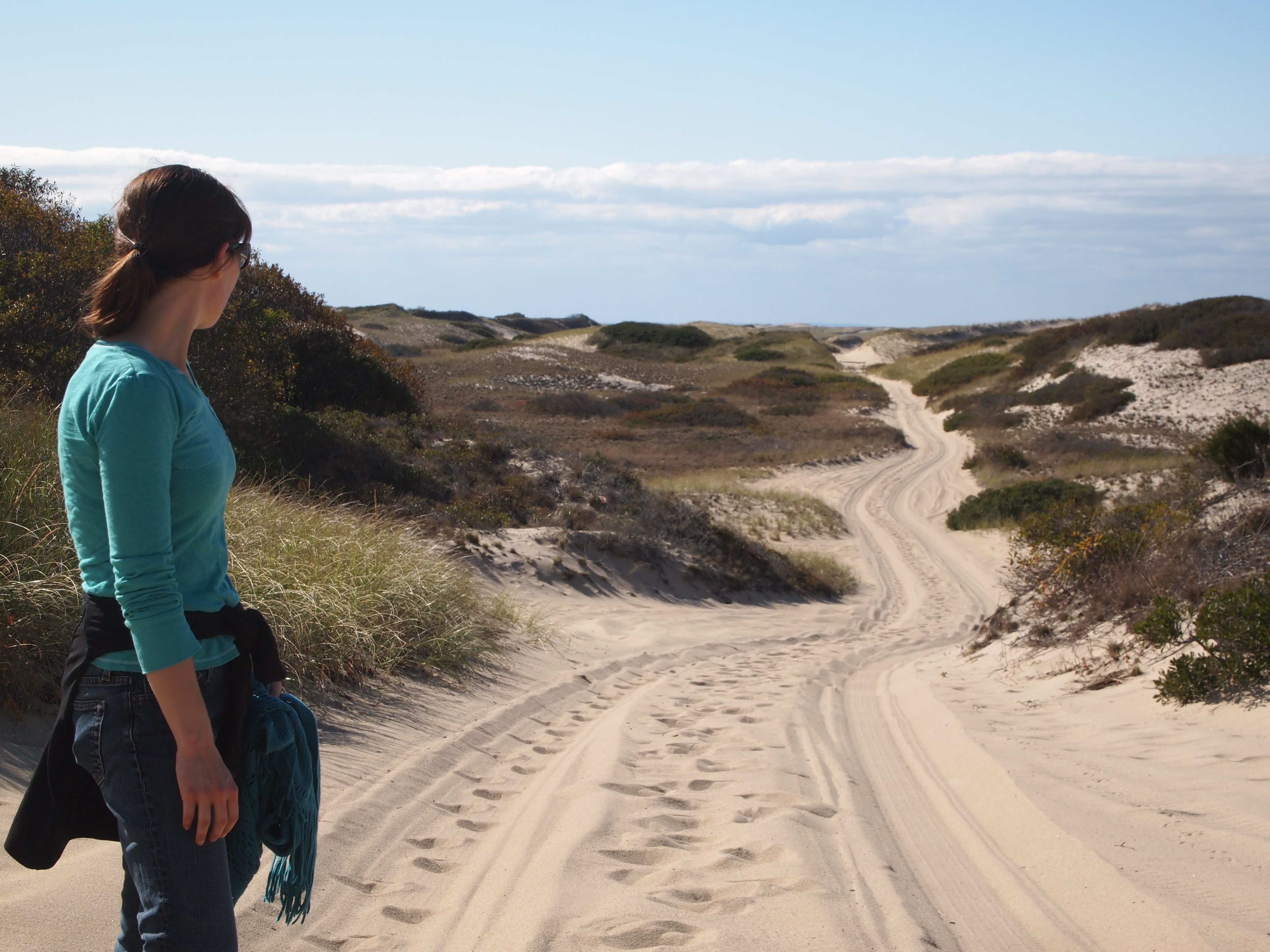
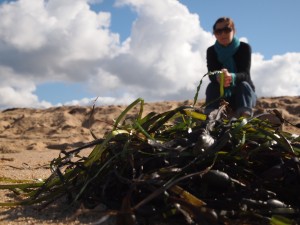
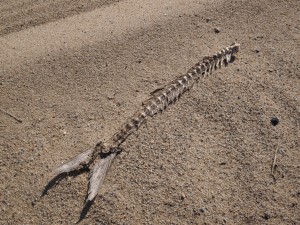

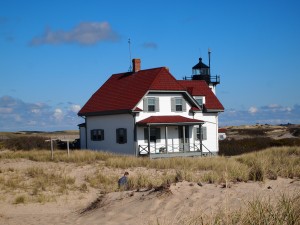
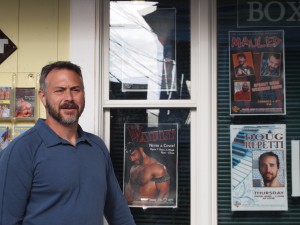
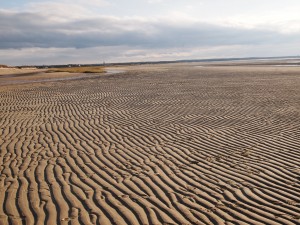
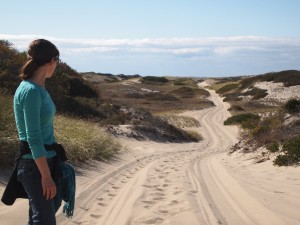

It seems “jollity and gloom were contending” for the afternoon.
The empire of our souls!